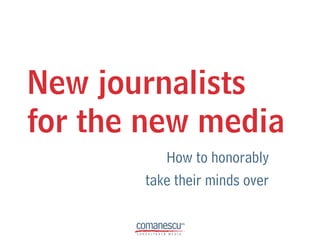New Journalists For The New Media
- 1. New journalists for the new media How to honorably take their minds over
- 2. What is a journalist? ’ā╗ ŌĆ×The conductor of a public journal, or one whose business it to write for a public journal; an editorial or other professional writer for a periodicalŌĆØ (Webster Unadbridged, 1913) ’ā╗ ŌĆ×A person who practises journalism, the gathering and dissemination of information about current events, trends, issues and peopleŌĆØ (Wikipedia, 2008). New journalists 2
- 3. This... ŌĆó ŌĆ×The JournalistŌĆØ, Thomas Rowlandson, 1786 New journalists 3
- 4. ...became THIS ŌĆó Reuters Mobile Journalism Toolkit, 2008 New journalists 4
- 5. Then & now ŌĆó Write ŌĆó Gather ŌĆó Think ŌĆó Copy ŌĆó Speculate ŌĆó Establish facts ŌĆó Transmit ŌĆó Receive ŌĆó Phisically go to source ŌĆó Virtually go to source or, (legwork) rather, ŌĆó Goes to information ŌĆó The source gets close via e-mail, press release, CCTV etc. (’¼üngerwork, eyework, earwork) ŌĆó Information comes to him New journalists 5
- 6. Contemporary journalist News agencies ŌŚÅ ŌŚÅ Rolling news televisions ŌŚÅ Radio + News sites ŌŚÅ ŌŚÅ Blogs ŌŚÅ E-mail ŌŚÅ Mobile/’¼üxed phone (SMS, talk) New journalists 6
- 7. Evolution ŌŚÅ The emphasis stands now on factual, and the amount of facts the journalist is to choose from is overwhelming ŌŚÅ The knowledge is acquired via proxy ŌĆō be it the internet, radio or something else ŌŚÅ The journalist is color-blind - reality or realities described via words and images are faint, far-away ŌŚÅ Distance can be overcome but can't be erased via the ŌĆ×information superhighwaysŌĆØ. ŌŚÅ The journalist is more dependent on his sources than his predecessors. New journalists 7
- 8. New PR approaches:┬ĀDO's ŌŚÅ Go for journalists' sources to in’¼éuence journalists: blogs are easy to reach and unexpensive. Press agency journalists are valuable ŌŚÅ Look for attention, rather than for total control ŌĆō it's very dif’¼ücult simply to be published ŌŚÅ Be very responsive to journalists' requests, no matter how exotic or hard to ful’¼üll they might be. You can always build something on responsivity ŌŚÅ Be concise. Serve the plain news - if you have none, your efforts are useless ŌŚÅ Intellectual ’¼éirt: disclose a small piece of info to arise journalists' curiosity ŌŚÅ Go multimedia ŌĆō send the full pack (pictures & audio & movies) ŌŚÅ Look for redundancy without repetition ŌĆō send your message via various channels in various forms ŌŚÅ Break your topic into pieces and negociate them as exclusive separately with various journalists ŌŚÅ Take over a broader area of a journalist's interest with neutral, newsworthy messages and then use the channel created to disseminate your own message, assuming again it's a powerful one. Become a valuable source on various topics ’¼ürst, and then use the attention you've got. New journalists 8
- 9. New PR approaches: DONT'S ŌŚÅ Don't insist ŌĆō journalists' patience is decreasing ŌŚÅ Don't try to bury the problem by delaying the answer. Journalists armed with mobile phones and internet are very effective in ’¼ünding their info elsewhere ŌŚÅ Avoid ŌĆ×marketeseŌĆØ, messages stuffed with weasel words are hard to digest, at least for journalists, no matter what copywriters might think ŌŚÅ Never try to impose an unique form for your message. Repetition is advertising, PR is diversity ŌŚÅ Don't lie. You might easily fool a journalist connected to you only via optic ’¼über, but consequences are dire once the lie is discovered. And it shall be. New journalists 9
- 10. Thank you ŌŚÅ www.comanescu.ro ŌŚÅ of’¼üce@comanescu.ro New journalists 10









